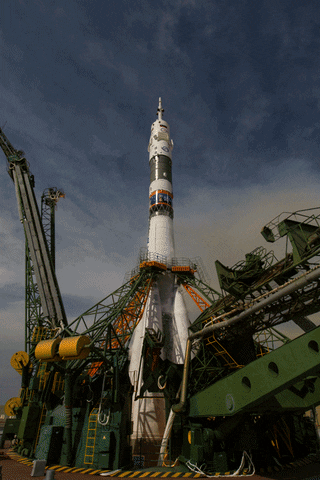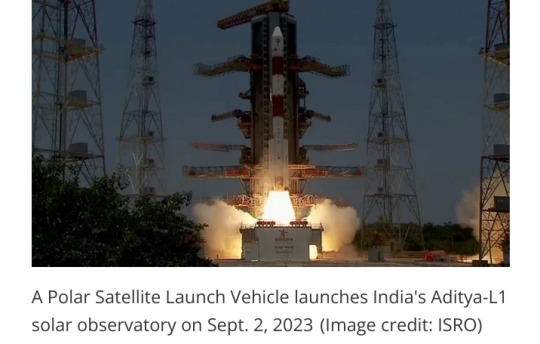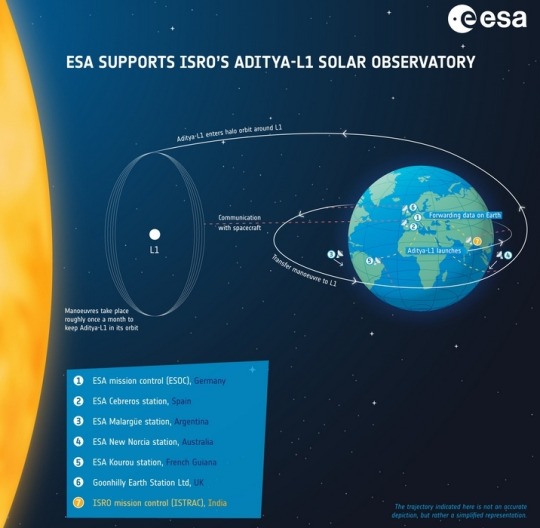#launch vehicle
Text

Apollo 11 Roll-Out - KSC - 20 May 1969
#NASA#Apollo#Apollo 11#Saturn V#Project Apollo#rocket#space vehicle#Vehicle Assembly Building#crawler#launch vehicle
22 notes
·
View notes
Photo

March 1969… Apollo 9 in Low Earth Orbit.
The official Apollo 9 mission logo, designed by Allen Stevens, showed all hardware for an Apollo lunar mission. The mighty Saturn V launch vehicle, the Command & Service Module and the Lunar Module.
The Apollo 9 mission evaluated spacecraft lunar module systems docking & rendezvous performance during manned Earth-orbital flight with CSM “Gumdrop” and LM “Spider”.
This is a high quality Bullion patch version of the Apollo 9 mission logo. Note the red “D” in McDivitt to mark this was the D-mission in alphabetical order of the Apollo Moon landing program.
The 10 days Apollo 9 mission ended with splash-down & recovery onboard USS Guadalcanal in the North Atlantic Ocean.
The wristwatch is an Omega Speedmaster chronograph, which has been the official wristwatch for NASA’s manned space program since March 1965.
(Photo: MoonwatchUniverse)
#Apollo#Astronaut#Aviator#321#chronograph#Omega#Speedmaster#NASA#military#LEO#Moonwatch#MoonwatchUniverse#SWFG#montres#uhren#sat#Saturn V#launch vehicle#spaceflight#The Right Stuff#Zulu time
30 notes
·
View notes
Photo

A Soyuz-FG rocket carrying a Soyuz TMA spacecraft launches from Baikonur Cosmodrome, Kazakhstan on 18 September 2006.
#Soyuz-U#soyuz fg#Kazakhstan#spacecraft#launches#cosmodrome#00's#2006#photography#Launch vehicle#USSR#Russia#Progress Rocket Space Centre
24 notes
·
View notes
Video
Artemis I Rollout (NHQ202208160017) by NASA HQ PHOTO
Via Flickr:
NASA astronauts Stan Love, left, and Don Pettit, right pose for a picture as NASA’s Space Launch System (SLS) rocket with the Orion spacecraft aboard atop the mobile launcher is rolled out of the Vehicle Assembly Building to Launch Pad 39B, Tuesday, Aug. 16, 2022, at NASA’s Kennedy Space Center in Florida. NASA’s Artemis I mission is the first integrated test of the agency’s deep space exploration systems: the Orion spacecraft, SLS rocket, and supporting ground systems. Launch of the uncrewed flight test is targeted for no earlier than Aug. 29. Photo Credit: (NASA/Joel Kowsky)
#spacecraft#launch vehicle#space launch system#artemis 1#kennedy space center#vehicle assembly building#astronauts#stan love#don pettit#artemis program#pre launch
18 notes
·
View notes
Text
What are your favorite launch vehicles? Retired, operational and future?
#space#launch#rocket#aerospace#engineering#nasa#spacex#launch vehicle#retired#operational#future#history#orbit
2 notes
·
View notes
Text
Launch vehicle reliability
I feel like there's a mistake people make in that they believe they can have a big impact on reliability with architecture decisions. In recent memory I think of this slide released by Virgin Orbit (RIP) in one of their investor decks.

Like I can simply tell you a launch vehicle's reliability via first stage engine count. This is superficial. LauncherOne didn't really have a large history to call on, but it's reliability is below theoretical with 4 out of 6 and was detached from whether they had 1 engine or 9. RocketLab has actually now crossed to 91%, beating theoretical. And both of the recent failures of Electron involved the single engine upper stage, not the 9 engine first stage. Astra was at 50%, which I suppose is technically correct as it's <88%. But myopic view as none of the failures are directly caused by the 5 engines. And there was more failures of the dirt simple single engine pressure fed upper stage than of the first stage.
These failures aren't baked around engineering margins which you can calculate; they are design, management and QC issues. And there isn't a formula that can output reliability from inputted cultural and management approaches at a company.
My favorite one is where SpaceX paid Futron Corporation back in 2004 for some analysis that showed that their single engine Falcon 1 was actually optimal from a reliability perspective and Falcon V was even better cause it could sustain engine out.
Engine Reliability
It was with this in mind that we designed Falcon I to have the minimum number of engines. As a result, there is only one engine per stage and only one stage separation event – the minimum pragmatically possible number.
In the case of Falcon V, there are five first stage engines, but the vehicle is capable of sustaining an engine failure at any point in flight and still successfully completing its mission. This actually results in an even higher level of reliability than a single engine stage. The SpaceX five engine architecture is an improved version of that employed by the Saturn V Moon rocket, which had a flawless flight record despite losing an engine on two of its missions.
Which is funny because they then arrived at a 9 engine setup (and later a 27 engine aha (AND NOW A 33 WOOO BABY)) and have to like it for reliability.
Falcon 9 has nine Merlin engines clustered together. This vehicle will be capable of sustaining an engine failure at any point in flight and still successfully completing its mission. This actually results in an even higher level of reliability than a single engine stage. The SpaceX nine engine architecture is an improved version of the architecture employed by the Saturn V and Saturn I rockets of the Apollo Program, which had flawless flight records despite losing engines on a number of mission.
Now in this regard eh. Falcon 1 flight 1 was lost because who knew metal valves would corrode under salt water spray. Flight 2 was lost because Elon thought they wouldn't need slosh baffles on the second stage as that would be wasted mass and overruled his engineers. Flight 3 was lost because of performance enhancements with Merlin 1C causing collision after staging due to residual thrust.
Falcon 9 then went on to have an engine failure on flight 5 and while it did still manage to achieve the launch, demonstrating the engine margin aspect, they did loose the secondary payloads. The two proper launch failures had to do with struts and COPV, which are entirely independent of engine count. We have had a more recent mission in early 2021 which had an engine fail and it still succeeded, although booster failed to land.
Another failure group that stick with me is The operationalization of Air Force space programs. 'We need to operationalize our launch vehicles such that a history major can run them instead of an engineer.' And so the upper ranks of the Air Force went ahead and dismantled the engineering culture that made these programs at least reliable and got rid of those "guys in white lab coats." And so they lost $5.6 billion worth of satellites and launch vehicles due to 3 failures that can all be attributed to poor quality control.
And that linked article makes a good point: "It is tempting to say that management is the cause of all launch failures, and in one sense that is true." Because if you just gave your engineers more time and money, they probably would have fixed the issues right? Well A. there's any number of things to spend your money on; you need to avoid bankruptcy and B. there are genuine engineering screw ups with time and money anyways. So better to just get off the pad and flying?
A final note on the R7 or Soyuz now. As a design, it has perhaps one of the worst conceptual reliabilities. It has 5 engines on the first stage with hydrogen peroxide turbopumps and not a single one of them can fail as they are each a booster. And because there is 4 boosters that means 4 separation events that also have to work. There is also a liquid third stage which of course has to separate and ignite successfully + the occasional 4 stage. 5 critical separation events and 6 engine burns that all have to go well. And yet it's reliability is kinda just fine with modern variant having 95.5%, with some older variants having better records. There was a stretch in the 1982 with 182 successful R7 family launches in a row.
You can't determine reliability from design parameters; because there is so much nuance in executions of programs
0 notes
Link
Radiation-Hardened Electronics for Space Application Market | BIS Research Report Analysis
The growth in the global radiation-hardened electronics for space applications market is expected to be driven by increasing demand for communication and Earth observation satellites.
Increasing deployment of electric propulsion capabilities across space missions has enhanced spacecraft’s vulnerability to radiation environments. Multiple deep space missions happening are driving the demand for radiation-hardened capabilities.
Download the Sample Report at: https://bit.ly/3zrC9Qy
#Silicon Carbide#Gallium Nitride#Silicon#Silicon on Sapphire#Silicon on Insulator#Single Event Effect#Total Ionization Dose#Small Satellites#Medium Satellites#Large Satellites (1#Launch Vehicle#Small and Medium-Lift Launch Vehicle#Heavy-Lift Launch Vehicles#Deep Space Probe#Lander#Rover#Orbiter
1 note
·
View note
Note
I think the unused land in the middle of traffic roundabouts should be turned into off-leash dog parks
Look I appreciate your vision but actual humans don’t even understand right of way in a traffic circle. I guarantee dogs do not either.
125 notes
·
View notes
Text

X-34 Technology Testbed Demonstrator.
Date: April 16, 1999
NASA ID: EC99-44976-34
#Orbital Sciences X-34#X-34#Spaceplane#Reusable Launch Vehicle#NASA#cancelled#suborbital reusable-rocket technology demonstrator#Advanced Space Transportation Program#ASTP#April#1999
58 notes
·
View notes
Text

Soyuz TMA-9 Launch
The Soyz TMA-9 spacecraft atop a Soyuz FG Launch Vehicle launches from the Baikonur Cosmodrome in Kazakhistan to deliver a crew to the International Space Station - 18 Sep 2003
#Spaceflight#Soyuz#TMA-9#spacecraft#rocket launch#blast off#space mission#rocket#launch vehicle#Soyuz mission
13 notes
·
View notes
Text
fucking love the mako controls in legendary. i never did the unc or mineral deposit missions in the og trilogy cause the mako was so hard to control but now hackett calls me up like "hey shepard buddy you wanna drive the mako off a cliff to stop my terrorist of the week" and im like "admiral i would be fucking stoked to drive the mako off a cliff to stop your terrorist of the week"
#its so FUCKING fun#i just drove my ass at an 85 degree angle up a cliff and LAUNCHED off the other side#what is the point of a video game vehicle if i cannot throw myself around for Sillies#mass effect#mass effect legendary#commander shepard
74 notes
·
View notes
Photo

#Soyuz MS-09#Soyuz-U#rocket#launchpad#Soyuz (rocket)#original Soyuz rocket#launch vehicle#Soyuz (rocket family)#soyuz fg#Kazakhstan#Space Centre
25 notes
·
View notes
Text

2 September 2022

Fresh off its success at the moon, India is now headed for the sun.
The nation launched its first-ever solar observatory today (Sept. 2), sending the Aditya-L1 probe skyward atop a Polar Satellite Launch Vehicle (PSLV) from Satish Dhawan Space Centre at 2:20 a.m. EDT (0620 GMT; 11:50 a.m. local India time).
The PSLV deployed Aditya-L1 into low Earth orbit (LEO) as planned about 63 minutes after liftoff, sparking applause and high fives in mission control.
"Congratulations, India, and congratulations, ISRO [the Indian Space Research Organisation]," Jitendra Singh, India's Minister of State for Science and Technology, said shortly after deployment on ISRO's launch webcast.
"While the whole world watched this with bated breath, it is indeed a sunshine moment for India," Singh added.
The successful launch followed on the heels of another big milestone for India: On August 23, its Chandrayaan-3 mission became the first to land softly near the moon's south pole.
Chandrayaan-3's lander-rover duo are expected to conk out in a week or so, when the harsh lunar night falls at their touchdown site. But Aditya-L1's long journey has just begun.
A long road to a good sun-viewing spot
Aditya-L1 won't stay in LEO forever:
After a series of checkouts, it will use its onboard propulsion system to head toward Earth-sun Lagrange Point 1 (L1), a gravitationally stable spot about 1 million miles (1.5 million kilometers) from our planet in the direction of the sun.
That destination explains the latter part of the mission's name. And the first part is simple enough: "Aditya" translates to "sun" in Sanskrit.
The 3,260-pound (1,480 kilograms) observatory will arrive at L1 about four months from now, if all goes according to plan.
But the long trek will be worth it, according to the ISRO.
"A satellite placed in the halo orbit around the L1 point has the major advantage of continuously viewing the sun without any occultation/eclipses," ISRO officials wrote in an Aditya-L1 mission description.
"This will provide a greater advantage of observing the solar activities and its effect on space weather in real time."
Indeed, another sun-studying spacecraft is already at L1 — the Solar and Heliospheric Observatory (SOHO), a joint NASA-European Space Agency mission that launched in December 1995.
(Several other spacecraft, including NASA's James Webb Space Telescope, are at Earth-sun Lagrange Point 2, which is a million miles from Earth, in the direction away from the sun.)

Solar flares, the coronal heating mystery and more
Once it's settled in at L1, the solar probe will use four three science instruments to study the particles and magnetic fields in its immediate surroundings and four others to scrutinize the sun's surface (known as the photosphere) and its atmosphere.
This work will help scientists better understand solar activity, including the dynamics of solar flares and coronal mass ejections (CMEs), ISRO officials say.
Flares are powerful flashes of high-energy radiation, and CMEs are huge eruptions of solar plasma.
Both types of outburst can affect us here on Earth. Intense CMEs that hit our planet, for example, trigger geomagnetic storms that can disrupt satellite navigation and power grids.
(As a side benefit, such storms also supercharge the gorgeous light shows known as auroras.)
Aditya-L1 will also tackle the "coronal heating problem," one of the biggest mysteries in heliophysics.
The corona — the sun's wispy outer atmosphere — is incredibly hot, reaching temperatures around 2 million degrees Fahrenheit (1.1 million degrees Celsius), according to NASA.
That's about 200 times hotter than the solar surface, which is "only" 10,000 degrees F (5,500 degrees C) or so.
It's still unclear what is responsible for this startling and counterintuitive discrepancy.
(Why would it be hotter away from the sun's core, where the energy-producing nuclear fusion reactions are occurring?)
Aditya-L1 has other science goals as well. For instance, the mission also aims to more fully flesh out the solar wind, the stream of charged particles flowing constantly from the sun, ISRO officials said.
Aditya-L1 will measure the composition of the solar wind and attempt to determine how it is accelerated.
And Aditya-L1 will do all this work on the cheap:
The mission's price tag is about 3.8 billion rupees, or $46 million US at current exchange rates.
That's in the same ballpark as Chandrayaan-3
India's first successful moon-landing mission costs about 6.15 billion rupees, or $74 million US.
For comparison, NASA's most recent big-ticket sun mission, the record-setting Parker Solar Probe, costs roughly $1.5 billion.
This disparity should not be viewed as an indictment of NASA, however; labor costs are much higher in the United States than in India, among other differences between the two nations' economies.

Aditya-L1 is a coronagraphy spacecraft to study the solar atmosphere, designed and developed by the Indian Space Research Organisation (ISRO) and various other Indian research institutes.
#India#Aditya-L1#Polar Satellite Launch Vehicle (PSLV)#Satish Dhawan Space Centre#low Earth orbit (LEO)#sun#Indian Space Research Organisation#Chandrayaan-3#Earth-sun Lagrange Point 1 (L1)#Solar and Heliospheric Observatory (SOHO)#solar flares#coronal mass ejections (CMEs)#coronal heating problem#heliophysics#solar wind#Parker Solar Probe#NASA#solar observatory#solar atmosphere
12 notes
·
View notes
Text
lmfao Starfield was more "finished" than Baldur's Gate 3.
#i say that as someone who thinks bg3 is one of the best games ever#starfield did not crash for me ONCE#bg3 act 3 was a fucking headache performance-wise#gale's romance is already broken again lmfao#tbd#fandom wank#i realise i am the cat in the cat w/knives meme but it has to be said#but at least andreja doesn't act like 'true love' was a casual fling that had the chance of being more at the end of the game 🤡#i woke up this morning and chose violence#but let me reiterate that starfield has many many flaws that should be talked about#but it is by far the most polished bethany game esp at launch#and it's not unfinished lol#there are things it definitely needed (fucking ground vehicles) but it is not unfinished
7 notes
·
View notes
Text
Once again experiencing the fun if slightly frustrating adventure when playing RPGs to find your character's Actual Outfit
#wandering over the words#August plays games#catch me literally making my V drive to every clothing store in the game to find Clothes#so quick might I add that my game struggled to load several times nrngrngn#just fucking launching myself at the counter wheezing like ''DO YOU HAVE COOL CLOTHES''#sorry Takemura!! can't help you rn buddy!! I'm having a ~FASHION MONTAGE~#my boy's been running after you lot all this time!! he's having some ME TIME!!!#(I already found his chosen weapon and vehicle now I need his clothes nrngn#I'm closer to finding The One. he now actually has the vibe I want him to have but they're not The Actual Clothes yet.#I allowed myself to look up the clothes in the game so I know. some examples of what I want.)
5 notes
·
View notes
Text
@nasa’s behemoth Crawler Transporter rolling into the VAB at Kennedy Space Center
#nasa#space#science#spaceflight#engineering#artemis#space launch system#spacecraft#nasa artemis#space exploration#technology#nasa sls#wearegoing#aerospace#kennedy space center#video#tank#vehicle#cars#heavyduty
24 notes
·
View notes